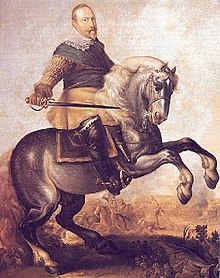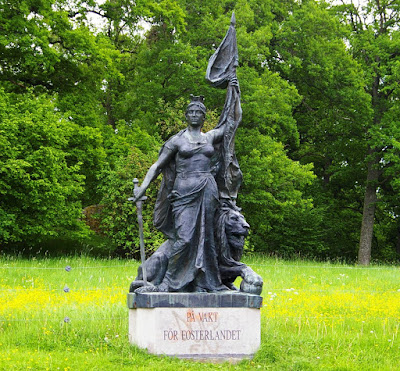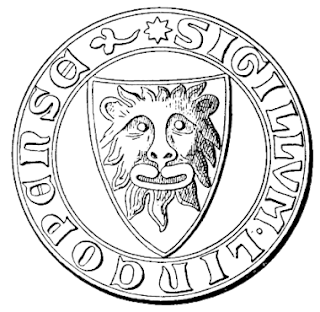The Lion of the North
Gustav II Adolf/Gustavus Adolphus II/"Gustav Adolphus the Great" (everyone they have titled "the great" has been an empire builder on behalf of them and their goals) "The Lion from the North"/"The Lion King"/"The Golden King"/"The Snow King"/"The father of modern warfare"/
Gustav II Adolf is considered to be uncomparable as the most skilled military leader of the Thiry Year's War.
A genious military strategy who was admired by Napoleon, Carl von Clausewitz and Hitler.
Young Lion King.
Adult Fat cat:
"The city shall stand here". Gustavus founded Gothenburg, Sweden's second largest city on the opposite coast of Stockholm.
Gustav II Adolf statue, on Gustav Adolf's square in the heart of Stockholm
During his reign, Sweden rose from the status of a Baltic Sea basin regional power to one of the great powers of Europe and a model of early modern era government. Gustavus Adolphus is famously known as the "father of modern warfare",[9] or the first great modern general. Under his tutelage, Sweden and the Protestantcause developed a number of excellent commanders, such as Lennart Torstensson, who would go on to defeat Sweden's enemies and expand the boundaries and the power of the empire long after Gustavus Adolphus' death in battle. Spoils of Adolphus' enemies meant he became a successful bookraider in Europe, specifically with Jesuit Collections.[10]
Called "The Golden King" and "The Lion of the North", he made Sweden one of the great powers of Europe, in part by reforming the administrative structure. For example, he began parish registration of the population, so that the central government could more efficiently tax and conscript the people.[11] Historian Christer Jorgensen argues that his achievement in the field of economic reform, trade, modernization, and the creation of the modern bureaucratic autocracy was as great as his exploits on the battlefields. His domestic reforms, which transformed a backward, almost medieval economy and society, were in fact not only the foundations for his victories in Germany, but also absolutely crucial for the creation and survival of the Swedish Empire.[12]
He is widely commemorated by Protestants in Europe as the main defender of their cause during the Thirty Years' War, with multiple churches, foundations and other undertakings named after him, including the Gustav-Adolf-Werk.
Military innovator[edit]
Historian Ronald S. Love finds that in 1560–1660 there were "a few innovators, notably Maurice of Nassau and Gustavus Adolphus of Sweden, whom many scholars credit with revolutionary developments in warfare and with having laid the foundations of military practice for the next two centuries."[14] Scholars all agree that Gustavus Adolphus was an extremely able military commander.[15] His innovative tactical integration of infantry, cavalry, logistics and particularly his use of artillery, earned him the title of the "Father of Modern Warfare". Future commanders who studied and admired Gustav II Adolf include Napoleon I of France and Carl von Clausewitz. His advancements in military science made Sweden the dominant Baltic power for the next one hundred years (see Swedish Empire). He is also the only Swedish monarch to be styled "the Great". This decision was made by the Swedish Estates of the Realm, when they convened in 1633. Thus, by their decision he is officially called Gustaf Adolf the Great (Gustavus Adolphus Magnus).
Gustavus Adolphus was the main figure responsible for the success of Swedish arms during the Thirty Years' War and led his nation to great prestige. As a general, Gustavus Adolphus is famous for employing mobile artillery on the battlefield, as well as very aggressive tactics, where attack was stressed over defense, and mobility and cavalry initiative were emphasized.
Among other innovations, he installed an early form of combined arms in his formations, where the cavalry could attack from the safety of an infantry line reinforced by cannon, and retire again within to regroup after their foray. Inspired by the reform of Maurice of Nassau he adopted much shallower infantry formations than were common in the pike and shot armies of the era, with formations typically fighting in 5 or 6 ranks, occasionally supported at some distance by another such formation—the gaps being the provinces of the artillery and cavalry as noted above. His artillery were themselves different—in addition to the usual complements of heavy cannon he introduced light mobile guns for the first time into the Renaissance battlefield. These were grouped in batteries supporting his more linearly deployed formations, replacing the cumbersome and unmaneuverable traditional deep squares (such as the Spanish Tercios that were up to 50 ranks deep) used in other pike and shot armies of the day. In consequence, his forces could redeploy and reconfigure very rapidly, confounding his enemies.[16][17] He created the modern Swedish navy, which successfully transported troops and supplies to the Continental battlefront.[18]
von Clausewitz and Napoleon Bonaparte considered him one of the greatest generals of all time, an evaluation agreed with by George S. Patton and others. He was also renowned for his constancy of purpose and the equality of his troops—no one part of his armies was considered better or received preferred treatment, as was common in other armies where the cavalry were the elite, followed by the artillery, and both disdained the lowly infantry. In Gustavus' army the units were extensively cross trained. Both cavalry and infantry could service the artillery, as his heavy cavalry did when turning captured artillery on the opposing Catholic Tercios at First Breitenfeld. Pikemen could shoot—if not as accurately as those designated musketeers—so a valuable firearm could be kept in the firing line. His infantrymen and gunners were taught to ride, if needed. Napoleon thought highly of the achievement, and copied the tactics. However, recent historians have challenged his reputation. B. H. Liddell Hart says it is an exaggeration to credit him with a uniquely disciplined conscript army, or call his the first military state to fight a protracted war on the continent. He argues that he improved existing techniques and used them brilliantly. Richard Brzezinski says his legendary status was based on inaccurate myths created by later historians. Many of his innovations were developed by his senior staff.[19]
While Gustavus has been widely credited for re-emphasizing the shock role of European cavalry, his innovations were hardly new, Huguenot cavalry under Henry IV and Gaspard II de Coligny having fought in exactly the same fashion during the French Wars of Religion. As a matter of fact his opponent Johann Tserclaes, Count of Tilly also favored the same ferocious charges the Swedish cavalry would become famous for. Neither was the Swedish practice of integrating shot and horse, the so-called "commanded shot", a new one, with the Huguenot horsemen at the battle of Coutras having the same supporting shooters. What made the Swedish army unique in this regard was the fact that the use of "commanded shot" became the standard tactical doctrine of its horse, and this in turn was adopted by other armies of the period, including its Imperial opponents and that of the English Civil War.[20]
Adolphus better deserved the credit of introducing a standard caliber light muskets to his infantry forces, replacing the previous mix of arquebus and heavy musket common in Imperial tercios. The shallower infantry formation of the Swedish brigade, much more conducive to massed firepower, was inspired by the work of Maurice. However Adolphus perfected the system and introduced the use of salvo fire, where two or three ranks of musketeers fired simultaneously, usually at point blank range, rather than one rank at a time counter marching as was common in that era. Delivered at point-blank range, and immediately followed up by a charge with swords, and pikes, a salvo became the infantry's most feared tactic because it was much more effective at breaking the enemy's morale and repulsing cavalry charges than the earlier method.[21]
Perhaps Adolphus’ greatest contribution, however, was his work in field artillery. Equipping each of his brigades with up to 12 light regimental guns, he greatly increased the organic firepower of his infantry and for the first time allowed the artillery arm to play a role in the offensive instead of being a static spectator in a battle of maneuvers.[22]
Political reforms[edit]
Gustav II Adolf's politics in the conquered territory of Estonia also show progressive tendencies. In 1631 he forced the nobility to grant the peasants greater autonomy. He also encouraged education, opening a school in Tallinn in 1631, today known as Gustav Adolf Grammar School (Estonian: Gustav Adolfi Gümnaasium).[23]On 30 June 1632, Gustav II Adolf signed the Foundation Decree of Academia Dorpatensis in Estonia, today known as the University of Tartu.[24] With policies that supported the common people, the period of Swedish rule over Estonia initiated by Gustav II Adolf and continued by his successors is popularly known by Estonians as the "good old Swedish times" (Estonian: vana hea Rootsi aeg).[25]
On 27 August 1617, he spoke before his coronation, and his words included these:
Military commander[edit]
Gustavus Adolphus inherited three wars from his father when he ascended the throne: against Denmark, which had attacked Sweden earlier in 1611; against Russia, due to Sweden having tried to take advantage of the Russian Time of Troubles; and against Poland, due to King Charles's having deposed King Sigismund III, his nephew, as King of Sweden.
The war against Denmark (Kalmar War) was concluded in 1613 with a peace that did not cost Sweden any territory, but it was forced to pay a heavy indemnity to Denmark (Treaty of Knäred). During this war, Gustavus Adolphus let his soldiers plunder towns and villages, and as he met little resistance from Danish forces in Scania, they pillaged and devastated twenty-four Scanian parishes. His memory in Scania has been negative because of that fear.[27] In the winter of 1612, during a period of two weeks, did he burn down, or otherwise destroyed 24 Scanian parishes and most of their population without meeting any enemy troops. The largest destroyed settlement was the Town Væ, which two years later was replaced by Danish King Christian IV as the nearby Christiansted (after the Swedification process, spelled Kristianstad), the last Scanian town to be founded by a Danish king.[28][29]
The war against Russia (Ingrian War) ended in 1617 with the Treaty of Stolbovo, which excluded Russia from the Baltic Sea. The final inherited war, the war against Poland, ended in 1629 with the Truce of Altmark, which transferred the large province Livonia to Sweden and freed the Swedish forces for the subsequent intervention in the Thirty Years' War in Germany, where Swedish forces had already established a bridgehead in 1628.
The weak electorate of Brandenburg was especially torn apart by a quarrel between the Protestant and Catholic parties. The Brandenburg minister and diplomat baron Samuel von Winterfeld influenced Gustavus Adolphus to support and protect the Protestant side in Germany. When Gustavus Adolphus began his push into northern Germany in June–July 1630, he had just 4,000 troops. He was soon able to consolidate the Protestant position in the north, however, using reinforcements from Sweden and money supplied by France at the Treaty of Bärwalde. After Swedish plundering in Brandenburg (1631) endangered the system of retrieving war contributions from occupied territories, "marauding and plundering" by Swedish soldiers was prohibited.[30] Meanwhile, a Catholic army under Johann Tserclaes, Count of Tilly was laying waste to Saxony. Gustavus Adolphus met Tilly's army and crushed it at the First Battle of Breitenfeld in September 1631. He then marched clear across Germany, establishing his winter quarters near the Rhine, making plans for the invasion of the rest of the Holy Roman Empire.
In March 1632, Gustavus Adolphus invaded Bavaria, a staunch ally of the Emperor. He forced the withdrawal of his Catholic opponents at the Battle of Rain, marking the high point of the campaign. In the summer of that year, he sought a political solution that would preserve the existing structure of states in Germany, while guaranteeing the security of its Protestants. But achieving these objectives depended on his continued success on the battlefield.
Gustavus is reported to have entered battle without wearing any armor, proclaiming, "The Lord God is my armor!" It is more likely that he simply wore a leather cuirass rather than going into battle wearing no battle protection whatsoever. In 1627, near Dirschau in Prussia, a Polish soldier shot him in the muscles above his shoulders. He survived, but the doctors could not remove the bullet, so from that point on, he could not wear iron armor; two fingers of his right hand were paralyzed.
https://en.wikipedia.org/wiki/Gustavus_Adolphus_of_Sweden
https://about-history.com/gustav-ii-adolph-of-sweden-the-lion-of-the-north/
https://www.investors.com/news/management/leaders-and-success/gustavus-adolphus-father-of-modern-warfare/
https://www.militaryhistoryonline.com/17thcentury/articles/geniusofsweden.aspx
http://svea.wikia.com/wiki/Gustav_II_Adolf
As far as I know, Gustav Adolphus is the only Swedish monarch who got an own day in the Swedish calender dedicated to him:
https://en.wikipedia.org/wiki/Gustavus_Adolphus_Day
"Gustavus Adolphus Day (Swedish: Gustav Adolfsdagen) is celebrated in Sweden and some other countries on 6 November in memory of King Gustavus Adolphus of Sweden, who was killed on that date (old style) in 1632 at the Battle of Lützen in the Thirty Years' War.[1][2] The day is named for the king[3] and is a general flag day in Sweden[3][4] and in Finland.[5] The day was formerly celebrated with torchlight processions and patriotic speeches.[3] Today what remains is mainly the consumption of the Gustavus Adolphus pastry (Gustav Adolfs-bakelse in Swedish) on this day, with a chocolate or marzipan relief of that king on top.[3]"
As far as I know, Gustav Adolphus is the only Swedish monarch who got an own day in the Swedish calender dedicated to him:
https://en.wikipedia.org/wiki/Gustavus_Adolphus_Day
"Gustavus Adolphus Day (Swedish: Gustav Adolfsdagen) is celebrated in Sweden and some other countries on 6 November in memory of King Gustavus Adolphus of Sweden, who was killed on that date (old style) in 1632 at the Battle of Lützen in the Thirty Years' War.[1][2] The day is named for the king[3] and is a general flag day in Sweden[3][4] and in Finland.[5] The day was formerly celebrated with torchlight processions and patriotic speeches.[3] Today what remains is mainly the consumption of the Gustavus Adolphus pastry (Gustav Adolfs-bakelse in Swedish) on this day, with a chocolate or marzipan relief of that king on top.[3]"



















Kommentarer
Skicka en kommentar